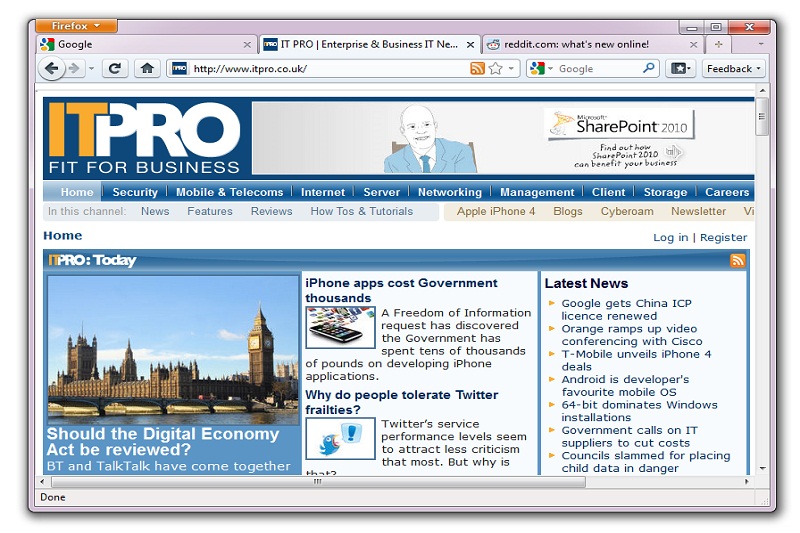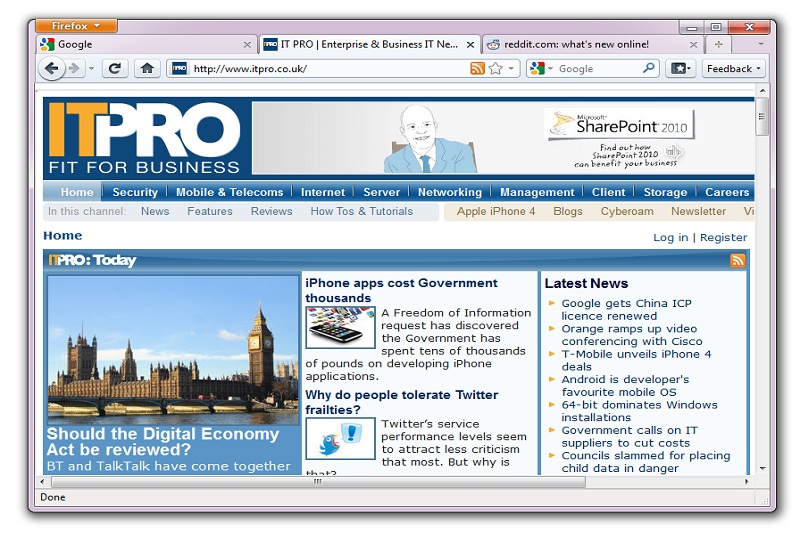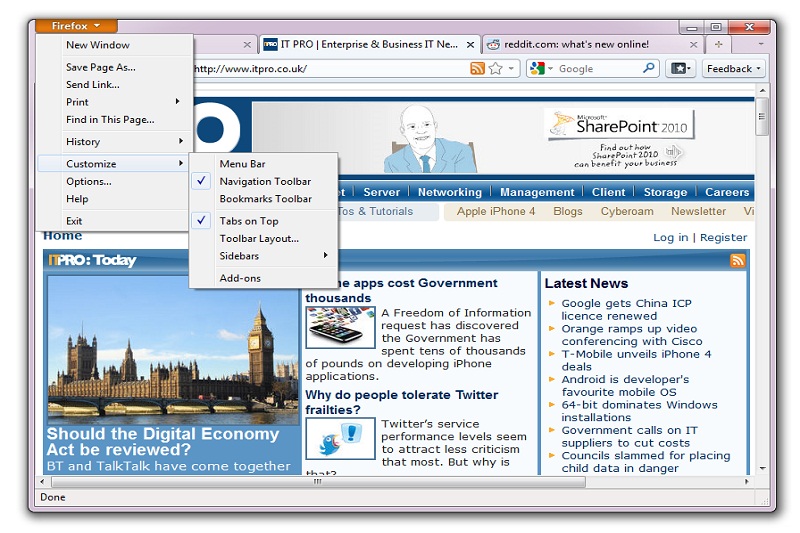Firefox 4 beta 1 review: First look
We take a look at the first public beta of Mozilla's Firefox 4 browser to see what new features and functionality it delivers.


Gone are the days when Mozilla Firefox could make a splash simply by not being Internet Explorer. Today it must compete not only with Microsoft's plodding browser, but also with the likes of Google Chrome, Apple Safari and the Opera browser a rather taller order.
Yet for now, Firefox 3 still boasts a market share of around 30 per cent, while its newer rivals have yet to break out of single digits. For that reason, the arrival of Firefox 4 is big news for the web, and this first public beta is a preview of what's to come.
User interface
Immediately on opening Firefox 4 you'll spot one change at least, you will if you're using Windows. On this platform the tabs now sit above the address bar, rather than below it, and for the final release both Mac and Linux versions are set to follow suit. That may spark accusations of plagiarism from fans of Chrome, which has had them there all along; but the designers insist it's a change based purely on usability analysis. If you're interested in the full story behind the change, there's a video presentation on the Mozilla blog that discusses the decision in depth.

We found it took no time at all to get used to, and was arguably more intuitive than the older design but if you hate it, you can simply untick the "Tabs on Top" menu option to return to the old arrangement.
More subtly, Firefox 4 on Windows also abandons the traditional menu bar, tucking its advanced controls away in a small drop-down in the top left corner, l'Office 2007. Further space is saved by hiding the bookmarks bar by default. These two changes maximise the area available for viewing web pages, but they could be confusing for novice users switching from Firefox 3. That's a shame, as until now the Firefox interface has been the most consistent among the non-Microsoft browsers.

[pb/New technologies
Sign up today and you will receive a free copy of our Future Focus 2025 report - the leading guidance on AI, cybersecurity and other IT challenges as per 700+ senior executives
For businesses, Firefox 4 brings no major enhancements there's still no management framework but some of its under-the-bonnet improvements could be invaluable in certain scenarios.
One such feature is enhanced support for the JS-ctypes library. This cryptically named resource enables developers to write advanced extensions of the sort that would previously have required delving into C++ in JavaScript. Since no platform-specific compilation is required, this makes it much easier to develop and maintain cross-platform extensions. The latest release of Safari also offers a JavaScript-based extension API, but using it means submitting to the legal and practical strictures of Apple's developer programme. With Firefox you're much freer, especially if you're developing extensions for internal use.
Another new technology in Firefox 4 is WebSockets, a communication protocol that lets the browser exchange data with a server with an overhead of just two bytes per message. To put that in context, Mozilla developer Christopher Blizzard estimates that "Google Wave, which tries to do real-time communication with keystrokes, has a several-kilobyte overhead for just about every keystroke." WebSockets is already implemented in the latest versions of Chrome and Safari, and for both in-house web applications and offsite services it has clear potential to slash network bandwidth requirements.
Firefox 4 also brings a degree of crash protection, so if a Flash, Silverlight or Quicktime plugin encounters a problem it shouldn't take down the whole browser. And an update to CSS closes a loophole that previously made it possible for websites to snoop details of other sites that you'd previously visited.
Darien began his IT career in the 1990s as a systems engineer, later becoming an IT project manager. His formative experiences included upgrading a major multinational from token-ring networking to Ethernet, and migrating a travelling sales force from Windows 3.1 to Windows 95.
He subsequently spent some years acting as a one-man IT department for a small publishing company, before moving into journalism himself. He is now a regular contributor to IT Pro, specialising in networking and security, and serves as associate editor of PC Pro magazine with particular responsibility for business reviews and features.
You can email Darien at darien@pcpro.co.uk, or follow him on Twitter at @dariengs.
-
 Cyber resilience in the UK: learning to take the punches
Cyber resilience in the UK: learning to take the punchesColumn UK law now puts resilience at the centre of cybersecurity strategies – but is legislation simply catching up with enterprise understanding that resilience is more than just an IT issue?
-
 CISPE claims European Commission gave Broadcom a ‘blank cheque to raise prices, lock-in, and squeeze customers’ with VMware deal
CISPE claims European Commission gave Broadcom a ‘blank cheque to raise prices, lock-in, and squeeze customers’ with VMware dealNews Cloud providers have issued a formal response to the General Court of the European Union after the Commission defended its approval of the deal
-
 Spanish spyware outfit uncovered, develops exploits for Windows, Chrome, and Firefox
Spanish spyware outfit uncovered, develops exploits for Windows, Chrome, and FirefoxNews Google was only able to discover the company after an anonymous submission was made to its Chrome bug reporting programme
-
 Firefox 95 boosts protection against zero-day attacks
Firefox 95 boosts protection against zero-day attacksNews Mozilla's browser now takes a more granular approach to walling off code
-
 Mozilla to end support for Firefox Lockwise password manager
Mozilla to end support for Firefox Lockwise password managerNews Replacement service already lined up as browser specialist continues to streamline business
-
 Firefox available on Microsoft Store for first time
Firefox available on Microsoft Store for first timeNews Gecko-based browser arrives after Microsoft removes restrictions
-
 Mozilla to cut 250 jobs as part of major coronavirus restructure
Mozilla to cut 250 jobs as part of major coronavirus restructureNews The reorganisation has been made so the company can become faster, more innovative, and find more revenue streams
-
 Why I’m leading a browser double life
Why I’m leading a browser double lifeOpinion There are benefits to using more than one browser
-
 Mozilla re-hires veteran Mitchell Baker to serve as CEO
Mozilla re-hires veteran Mitchell Baker to serve as CEONews The interim chair and CEO formally rejoins the organisation after Chris Beard stepped down in December 2019
-
 Mozilla fixes two Firefox zero-days being actively exploited
Mozilla fixes two Firefox zero-days being actively exploitedNews Critical vulnerabilities allow attackers to execute arbitrary code or trigger crashes
